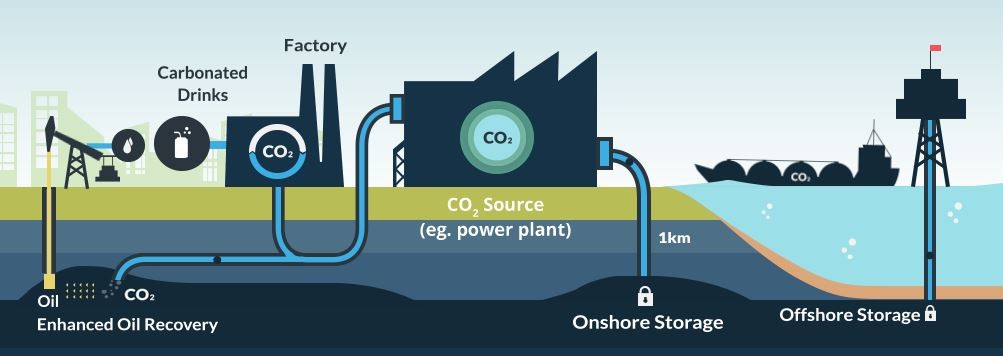Evaluate the feasibility of the Carbon Capture Usage and Storage (CCUS) technology in helping us achieve our net-zero emissions goals.
As India remains committed to achieving net-zero emissions by 2070, nuclear energy alongside technologies like Carbon Capture Usage and Storage (CCUS) are emerging as key components of its strategy for decarbonisation and green transition.
Carbon Capture Usage and Storage Technology (CCUS)
- CCUS refers to an array of technologies designed to capture carbon dioxide (CO₂) emissions from large point sources such as thermal plants, oil refineries, and the steel and cement industries. The captured CO₂ is either transferred into the earth or reused for industrial applications in various forms.
- The key objective of CCUS is to prevent CO₂ from being released into the atmosphere. In doing so, it interrupts the cycle of carbon that contributes to the greenhouse effect and global warming.
3 Stages of CCUS:
First stage: The first stage involves the capture of carbon. There are different types of carbon capture technologies, and their use is determined by the nature of the gas stream and the intended application. For instance, when the gas streams contain lower concentrations of CO₂ – such as flue gas streams in steel plants or in refineries – the chemical-solvent based capture technology is preferred.
Second stage: The second stage involves the utilisation of captured carbon. As far as the costs of capturing carbon are concerned, gasification processes cost the least as carbon capture is already integrated into most of these systems. In comparison, coal-based plants, which emit low CO₂ concentrations, incur higher costs. The captured carbon is converted into value-added products such as green urea, dry ice, carbonated drinks, building materials and chemicals.
Third stage: Finally, the third stage entails storing the CO₂ in saline aquifers, depleted oil and gas fields, and other similar geological formations.
Significance of CCUS in countering climate change and pushing for net zero emission targets:
- Internationally, CCUS has been legitimised as a key technology to tackle climate change. The idea was further endorsed at the 28th Conference of Parties (COP28) held in Dubai in 2023.
- According to the International Atomic Energy Agency database, CCUS capacities currently in operation globally measure up to 50 million tons per year with individual projects in countries such as Brazil, the US, and Australia each capturing more than three million tons per year.
- Amidst the growing efforts towards net-zero emissions globally, the narrative around CCUS technology has gained significant momentum in India – the third largest emitter of carbon dioxide in the world after China and the US.
- In November 2022, NITI Aayog published a report outlining the potential of CCUS technology in India and a possible roadmap for its deployment.
2 Pronged benefits of CCUS:
Decarbonisation: CCUS has tremendous potential for reducing emissions in hard-to-abate sectors such as coal, steel, cement, oil refineries, which form the backbone of Indian industry. As these sectors will grow in the coming decade, the CCUS technology will help determine the long-term viability of industrial development in India.
Energy Transition: The captured CO₂ can be converted into green fuels such as hydrogen, green ammonia, methane, etc. Thus, CCUS also plays an important role in facilitating the transition to cleaner energy sources and complementing options like solar and wind power.
Challenges associated with CCUS:
- High costs and risks: For instance, Direct Air Capture (DAC) – a method that captures carbon directly from the air regardless of the source or concentration – is in its nascent phase. Most DAC systems largely exist in theory or scientific papers and have been demonstrated successfully in controlled laboratory conditions.
- Policy push to increase investment: Since CCUS technology remains a niche area, it has yet to attract significant businesses and investors. While coal gasification, hydrogen, and methane are said to be sunrise sectors, investments in them seem unlikely to increase without targeted policy support.
- The ‘storage’ component (i.e. carbon sequestration) has several issues in India – such as lack of data, the limited availability of aquifers (underground layers of water-bearing rock) and similar geological formations.
Way forward:
- Experts have cautioned that even with CCUS technology, carbon abatement will be modest unless the three components of this technology –– capture, usage and storage –– are effectively integrated.
- The NITI Aayog report recognises that a multi-pronged policy approach is needed to develop the CCUS market. Recommended measures include tax and cash credits to investors, early-stage financing options for projects, options for public-private partnership, easy procurement of raw materials, Production Linked Incentives (PIL) schemes, etc.
- Hence, a well-defined and clear strategy is needed for the permanent disposal of captured carbon. This is specifically important because, despite its history marked by both promise and hesitation, CCUS continues to receive attention both globally and in India.
Source:

